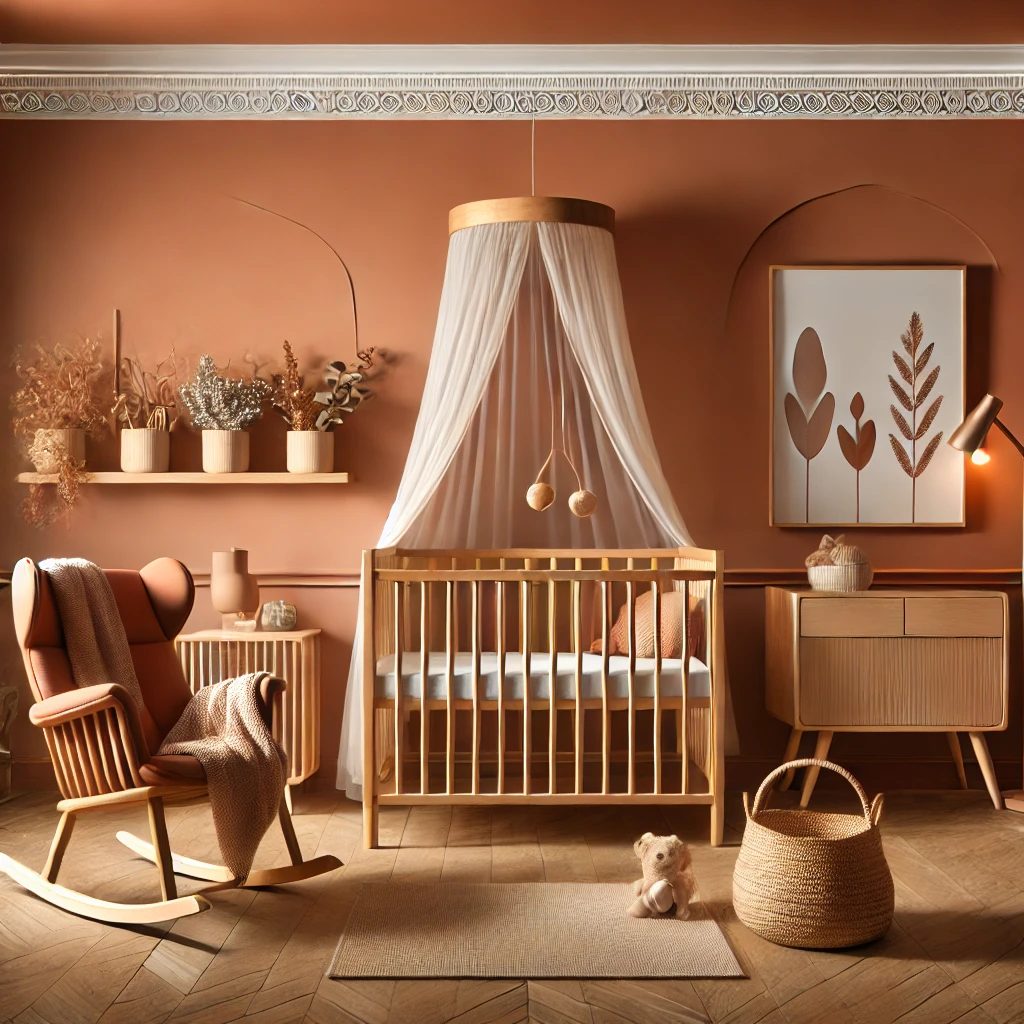Welcoming a new life into your home is an exhilarating journey that begins with creating a sanctuary that feels both nurturing and aesthetically pleasing.
The resurgence of terracotta—with its rich, earthy tones and natural appeal—has transcended mere garden pots to become a sophisticated design element in contemporary nurseries.
This warm hue evokes a sense of groundedness and stability, qualities we inherently wish to bestow upon our little ones as they embark on their life’s odyssey.
Terracotta, derived from the Italian words for “baked earth,” brings an organic authenticity that synthetic colors simply cannot replicate. Its versatility allows it to serve as either a dominant theme or a subtle accent, harmonizing effortlessly with various design aesthetics from bohemian to minimalist.
Whether you’re drawn to its connection with nature or its ability to create a cozy ambiance, terracotta offers a timeless quality that will grow with your child, eliminating the need for frequent redecorating as trends fluctuate.
Terracotta Nursery Ideas
As we explore these twelve innovative approaches to incorporating terracotta into your nursery design, consider how this ancient material can create a space that feels both contemporary and timeless—a perfect metaphor for the enduring love you have for your child coupled with the fresh beginnings their arrival represents.
1. Terracotta Wall Accent
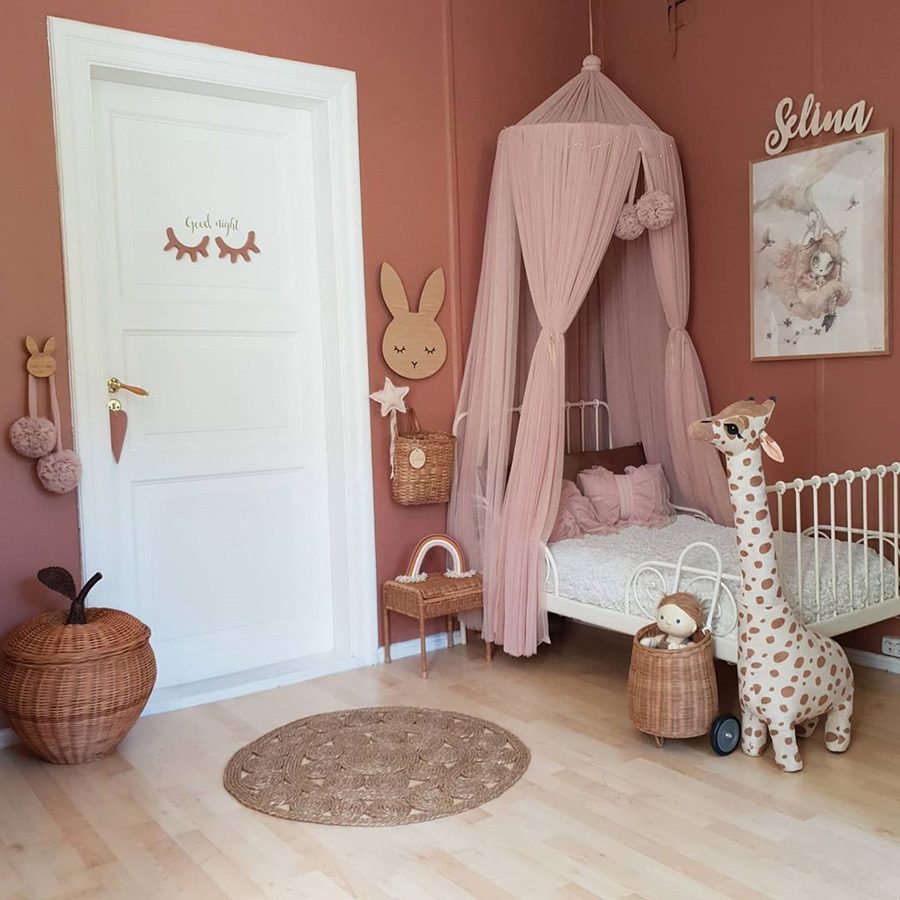
A terracotta accent wall serves as a striking focal point in any nursery, infusing the space with warmth and character without overwhelming the senses. Unlike bright primary colors that might overstimulate an infant, terracotta’s muted earthiness creates a soothing backdrop that promotes tranquility and rest—essential elements for both baby and parents during those early months.
The beauty of choosing terracotta paint lies in its versatility when paired with other elements. White furniture pops dramatically against this warm backdrop, while natural wood tones create a cohesive, organic feel.
Consider incorporating textural elements like macramé wall hangings or woven baskets to enhance the earthy aesthetic and add visual interest that will captivate your growing baby’s developing visual perception.
2. Terracotta and Sage Green Color Scheme
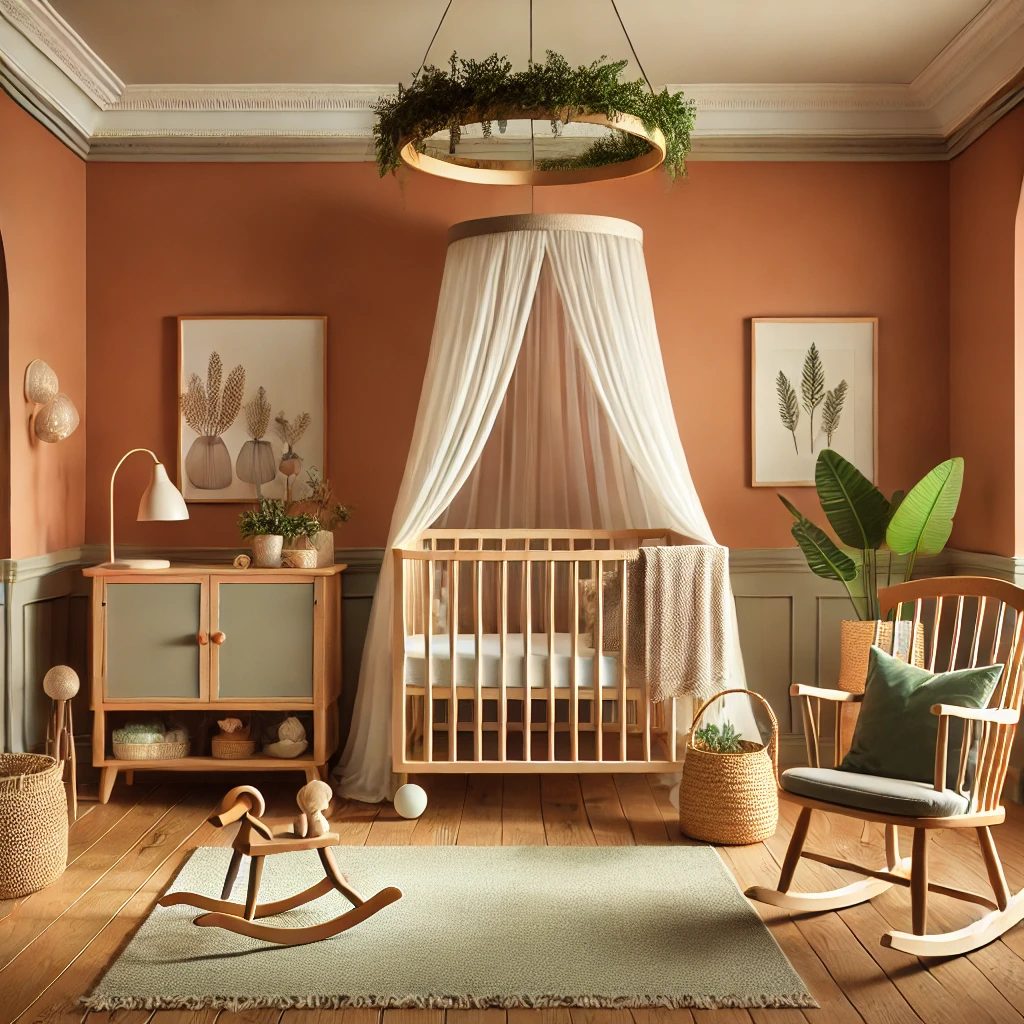
The combination of terracotta and sage green creates a sophisticated palette that brings the serenity of nature indoors. This pairing works particularly well because these complementary colors balance each other—the warmth of terracotta offsetting the coolness of sage, resulting in a visually pleasing environment that feels both fresh and grounded.
Implement this duo through sage green walls with terracotta accessories, or vice versa. Add white or cream accents to prevent the space from feeling too heavy.
This nature-inspired color scheme adapts beautifully as your child grows, transitioning seamlessly from infancy to toddlerhood without necessitating a complete redesign. Consider incorporating botanical prints or leaf motifs to enhance the natural theme, creating a nursery that feels like a peaceful garden sanctuary.
3. Terracotta Ceiling Design
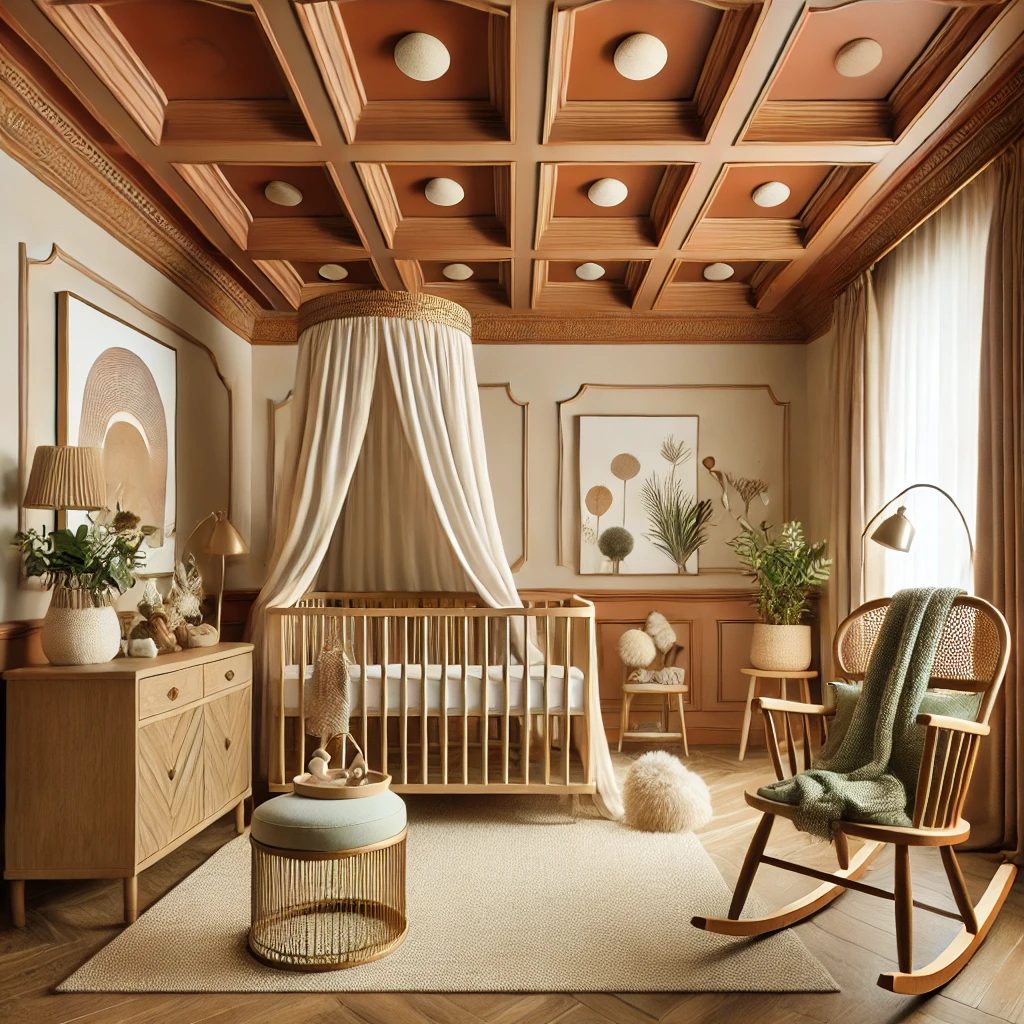
For a truly unique approach, consider bringing terracotta to the often-overlooked “fifth wall”—the ceiling. A terracotta ceiling creates an unexpected element of design interest while maintaining a cozy atmosphere. This approach is particularly effective in rooms with ample natural light, where the warm hue can reflect a subtle, flattering glow throughout the space.
Pair a terracotta ceiling with neutral walls to avoid visual heaviness. This design choice creates an enveloping feeling of security—almost like a warm embrace surrounding your baby. For added interest, consider a textured finish or even a geometric pattern in varying shades of terracotta.
Remember that infants spend significant time looking upward, so this unconventional choice provides stimulating visual interest during those important developmental months.
Related Guide: 14 Eclectic Baby Nursery Ideas
4. Textured Terracotta Elements
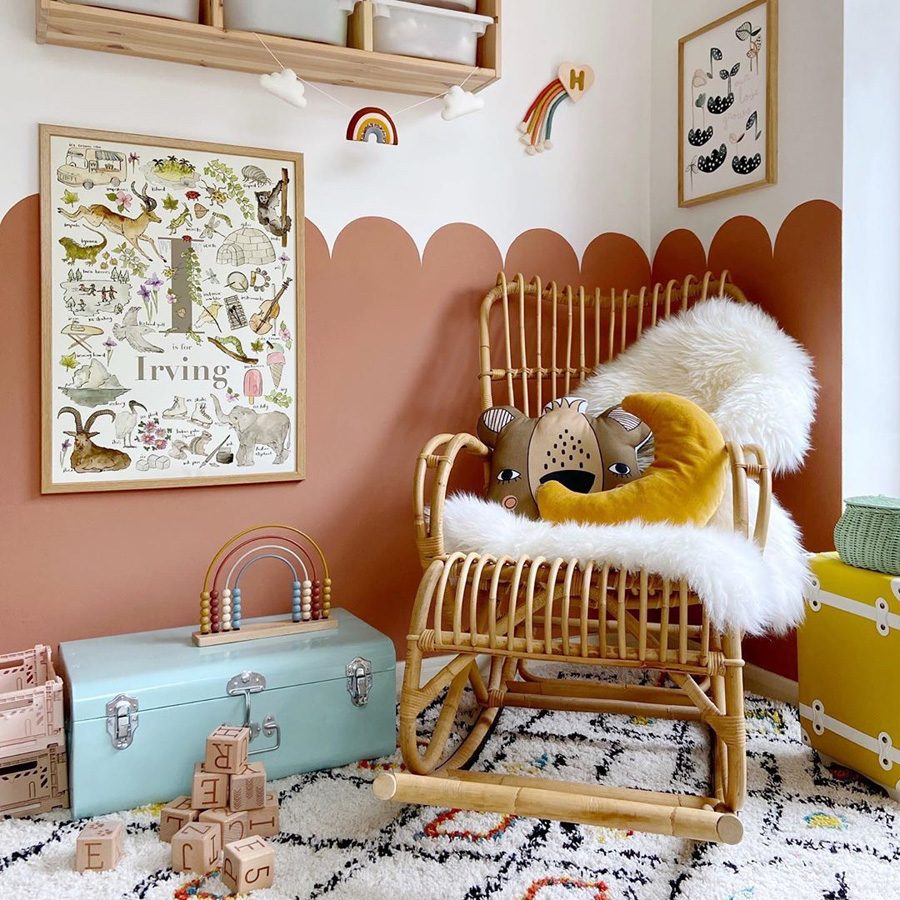
Incorporating textural terracotta elements adds depth and dimension to your nursery design. Consider terracotta ceramic pendant lights, textured wall hangings, or sculptural decorative pieces that introduce this earthy tone while simultaneously providing tactile interest. These elements add sophistication that elevates the nursery beyond typical juvenile decor.
Textured terracotta also offers sensory benefits for your developing baby, providing visual complexity that stimulates cognitive development. Place these elements strategically throughout the room—perhaps a textured lamp base near the changing table or a sculpted wall piece visible from the crib.
The interplay of light and shadow on textured surfaces creates a dynamic environment that evolves throughout the day, providing subtle visual stimulation as natural light shifts across these organic forms.
5. Terracotta Furniture Accents
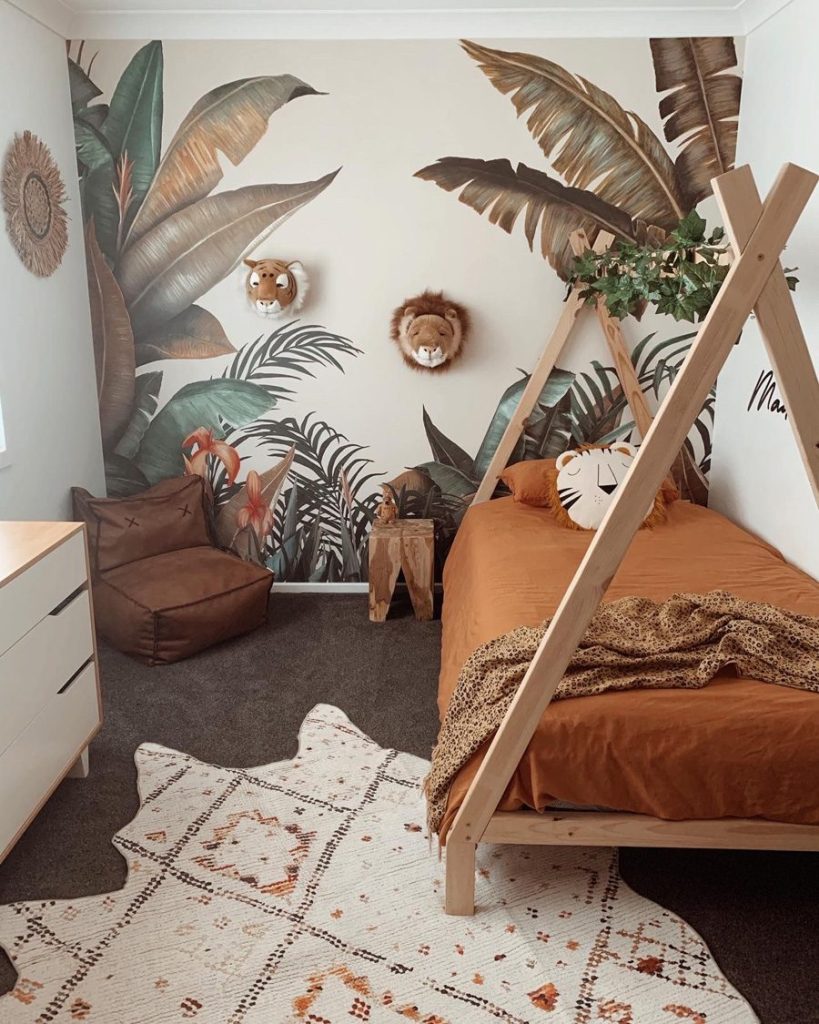
Incorporating terracotta through furniture accents offers a commitment-free way to embrace this trend. Consider a rocking chair with terracotta upholstery, drawer pulls in this warm tone, or even a painted furniture piece that introduces this color without dominating the space. These smaller elements can be easily updated as your design preferences evolve.
The psychological benefits of terracotta furniture accents shouldn’t be overlooked. The warm, earthy tone creates a sense of security and stability—qualities particularly beneficial in a nursery environment.
Position these accent pieces where they’ll receive the most interaction, such as a terracotta-toned ottoman near the nursing chair or a small side table finished in this rich hue, allowing the color to become associated with moments of connection and comfort between parent and child.
6. Terracotta Textiles
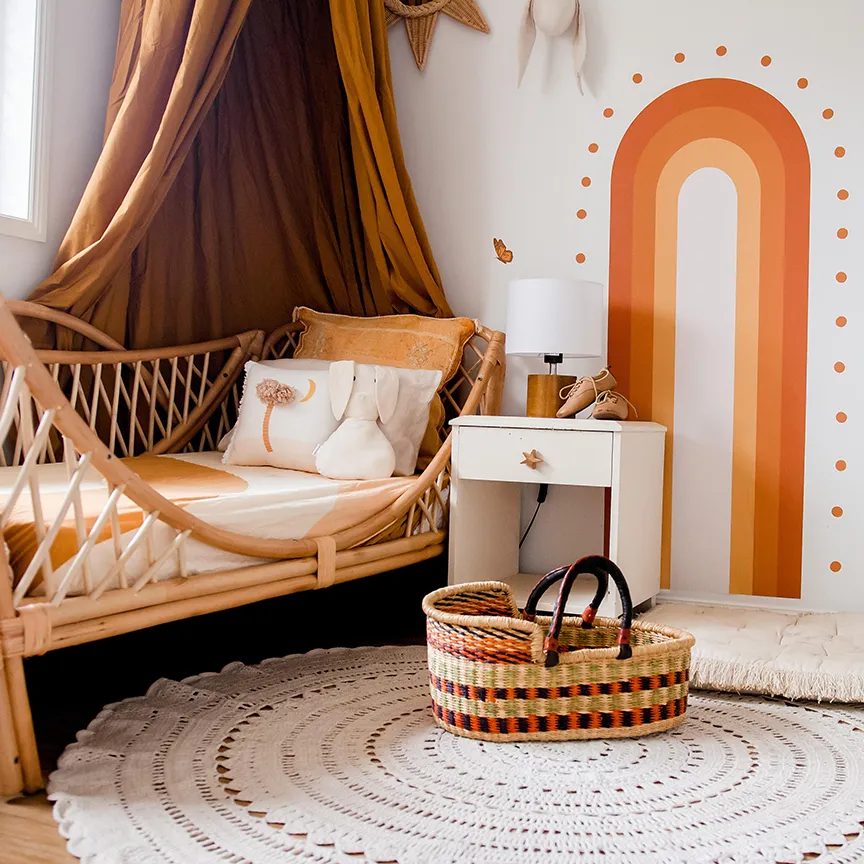
Soft textiles offer perhaps the most adaptable way to introduce terracotta into your nursery design. From curtains and crib sheets to throw pillows and area rugs, fabric elements in varying shades of terracotta add warmth while being easily changeable. Layer different tones and textures for a nuanced approach that avoids monotony.
Beyond aesthetics, terracotta-hued textiles bring practical benefits. The earthy tone naturally disguises minor stains better than lighter colors—an undeniable advantage in a baby’s space. Select organic cotton or linen fabrics when possible to complement the natural essence of terracotta.
Consider seasonal rotations: lighter terracotta tones for spring and summer, deeper clay hues for fall and winter, allowing the nursery to evolve with the changing seasons while maintaining its cohesive design foundation.
7. Terracotta Nursery Storage Solutions
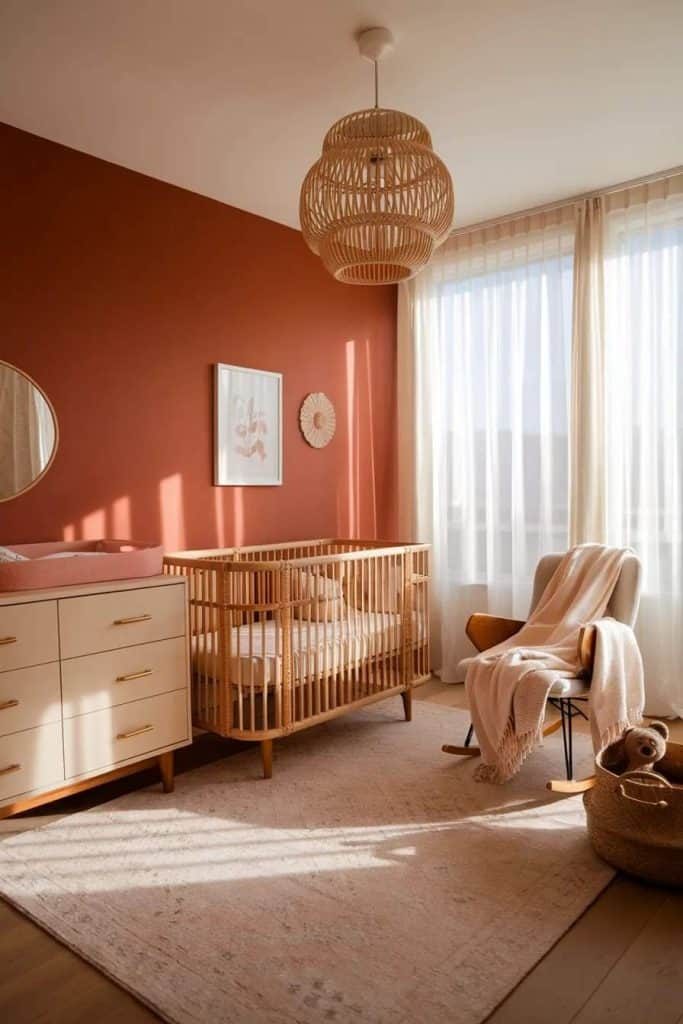
Functional storage becomes a design feature with terracotta-colored baskets, bins, and shelving units. These organizational elements add color while corralling the inevitable accumulation of baby essentials. The earthy tone adds sophistication to utilitarian items, elevating the overall design aesthetic while maintaining practicality.
Consider woven terracotta baskets for storing blankets, handcrafted terracotta pots for small items, or painted terracotta-hued wooden crates for books and toys.
Position these storage solutions at varying heights—some accessible to growing toddlers to encourage independence, others higher up for items requiring parental supervision. This thoughtful organization system will adapt as your child grows, providing long-term functionality while maintaining the design integrity of your terracotta-themed nursery.
8. Terracotta Botanical Nursery
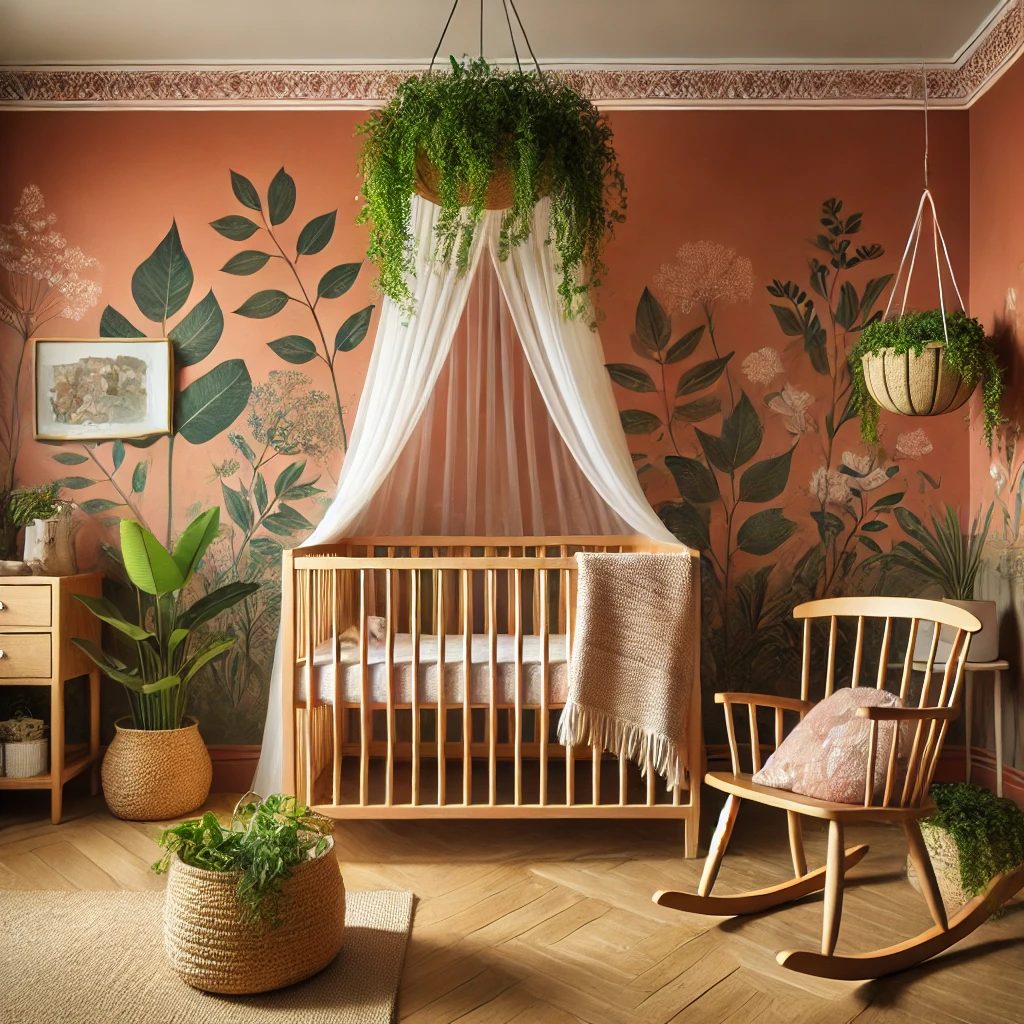
Blend terracotta with abundant plant life for a biophilic nursery design that connects your baby to nature from day one. Terracotta planters housing child-safe plants create a nurturing environment that improves air quality while introducing natural elements. This approach creates a multi-sensory experience beneficial for cognitive and emotional development.
Select plants with varying textures and shapes, housing them in differently sized terracotta pots grouped at varying heights. Consider hardy, low-maintenance varieties like spider plants or boston ferns that thrive with minimal care—an important consideration during busy newborn days.
Position plants safely out of reaching distance from the crib but visible during diaper changes or feeding times, allowing your baby to observe the gentle movement of leaves and the interplay of light through foliage.
9. Terracotta Art and Decorative Pieces
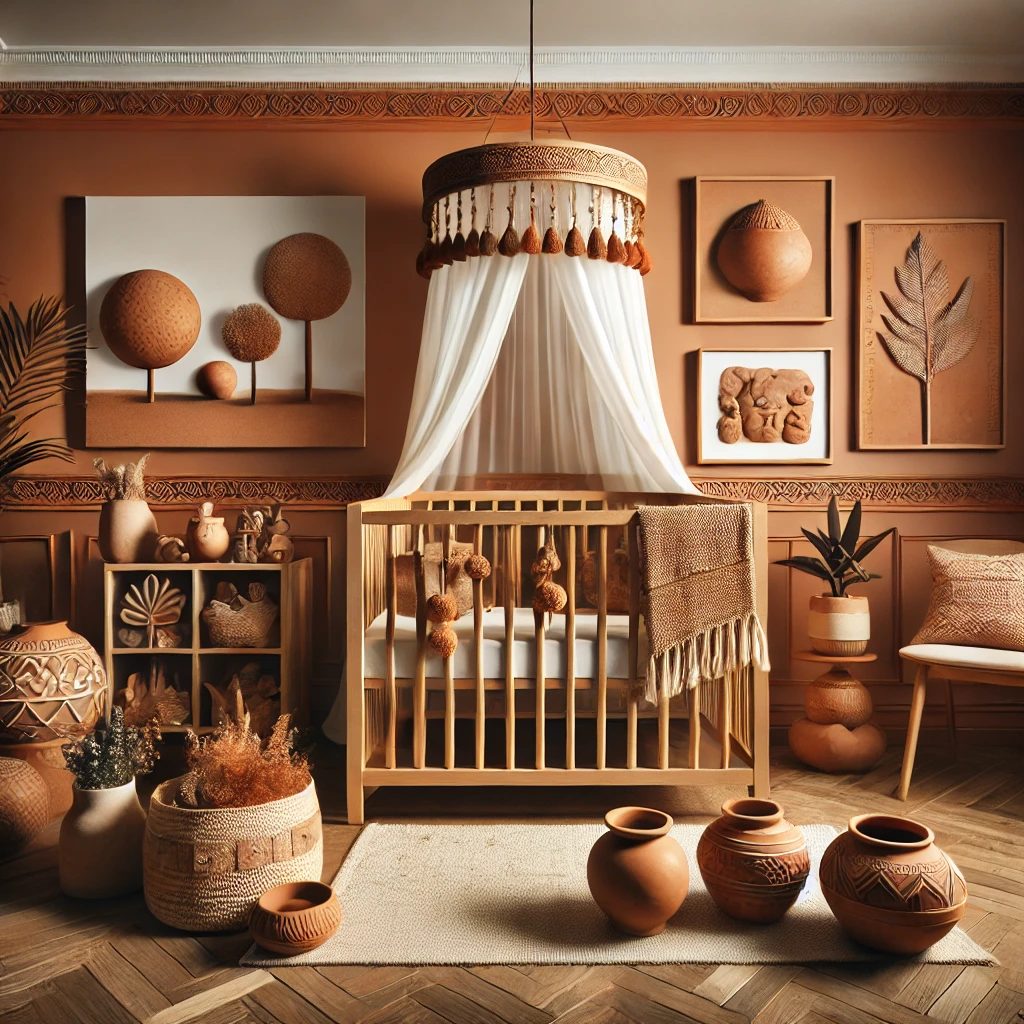
Artwork and decorative elements in terracotta tones add personality and visual interest to your nursery walls. Consider abstract paintings with terracotta as a dominant color, framed terracotta-colored textiles, or ceramic wall sculptures that introduce this earthy hue. These artistic elements create focal points that stimulate visual development.
Position art at various heights—some at adult eye level for your enjoyment, others lower where an eventually mobile baby can appreciate them. Select pieces with varying patterns, textures, and shades of terracotta to create a gallery that evolves in interest as your child’s visual perception becomes more sophisticated.
Consider incorporating wall art that features subtle educational elements like shapes or nature motifs that will remain relevant as your baby grows into a curious toddler.
Related Guide: 14 Boho Nursery Wall Decor Ideas
10. Terracotta Lighting Features
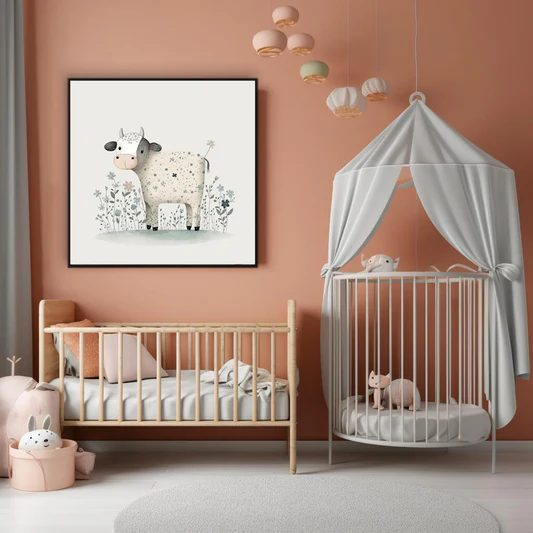
Lighting filtered through terracotta-colored shades casts a warm, flattering glow that’s perfect for late-night feedings and diaper changes. Consider ceramic pendant lights, table lamps with terracotta bases, or even a statement chandelier with terracotta elements. These fixtures become functional art pieces that enhance the overall design scheme.
Layer your lighting approach with multiple sources at different heights: a main ceiling fixture, wall sconces at adult height, and perhaps a small nightlight in a terracotta holder near the floor.
This creates a flexible lighting environment that adapts to various needs—bright for playtime and changing, dim for pre-sleep routines. The warm light filtering through terracotta elements creates a soothing ambiance that signals security and comfort, potentially aiding in establishing healthy sleep associations.
11. Terracotta Window Treatments
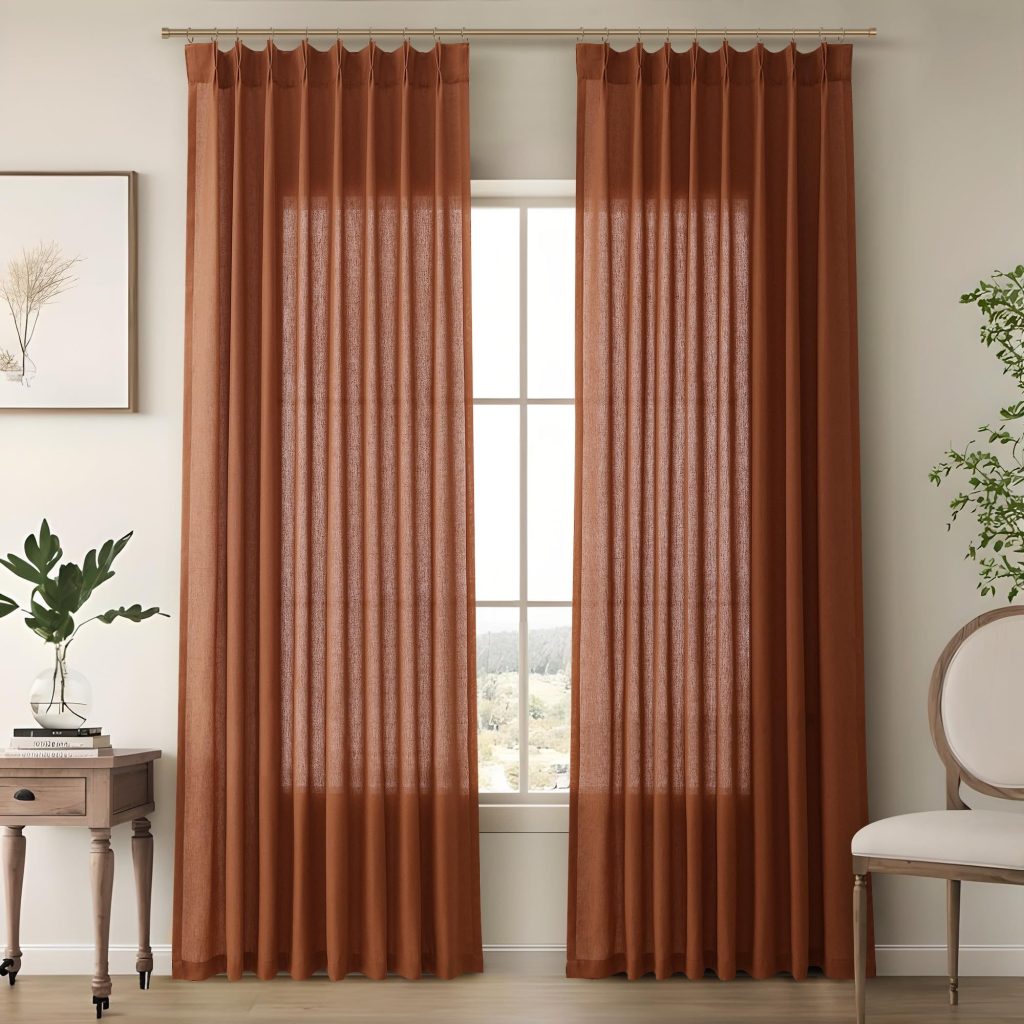
Window coverings in terracotta hues not only complete your design scheme but serve the critical function of light control for your baby’s sleep. Consider roman shades, curtains with subtle terracotta patterns, or wooden blinds stained in a compatible terracotta tone. These elements frame your windows while harmonizing with the overall design concept.
Beyond aesthetics, prioritize blackout capabilities—particularly important for daytime naps and early bedtimes while summer evenings remain bright. Layer sheer terracotta-tinted panels with heavier blackout curtains for flexibility in light control.
Position curtain rods higher than the window frame to create an illusion of height, making the nursery feel more spacious. This thoughtful approach to window treatments balances form and function, addressing the practical needs of a nursery while maintaining design cohesion.
12. Terracotta Flooring Options
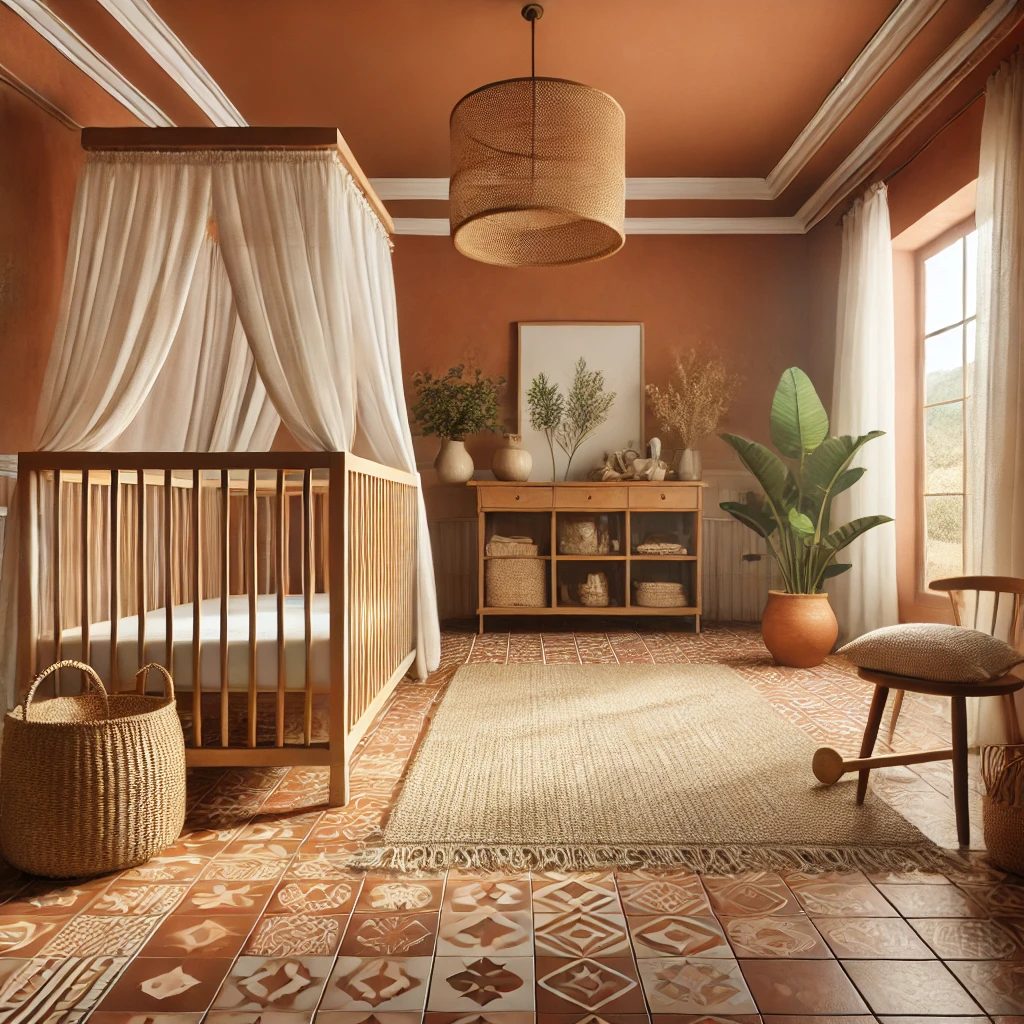
For a bold commitment to the terracotta theme, consider flooring options that incorporate this earthy tone. From actual terracotta tiles (with appropriate area rugs for warmth and safety) to vinyl or carpet in complementary hues, your flooring choice creates a foundation for the entire design scheme. This grounding element completes the cohesive feel of a terracotta-inspired nursery.
If authentic terracotta tiles feel too permanent, explore washable rugs with terracotta patterns or undertones that provide the aesthetic while maintaining practicality. Position a soft, plush area rug in the play zone to provide a comfortable surface for tummy time and eventual crawling explorations.
Consider the transition between the nursery flooring and adjacent rooms, selecting options that create harmonious flow throughout your home while still allowing the nursery to maintain its unique terracotta-inspired identity.
Conclusion
The integration of terracotta elements into nursery design represents more than a passing trend—it embodies a return to natural materials and colors that create spaces of genuine warmth and serenity.
By thoughtfully incorporating terracotta through these twelve approaches, you create an environment that balances aesthetic sophistication with the practical requirements of a baby’s first room.
As you prepare to welcome your little one, remember that the most nurturing spaces combine intentional design with authentic love and attention. The warm embrace of terracotta creates a visual metaphor for the warmth of your arms—a perfect symbolism for this precious new chapter.
Whether you embrace terracotta boldly or introduce it through subtle accents, this earthy hue provides a timeless foundation that will grow and evolve alongside your child, creating a space where countless precious memories will unfold.

